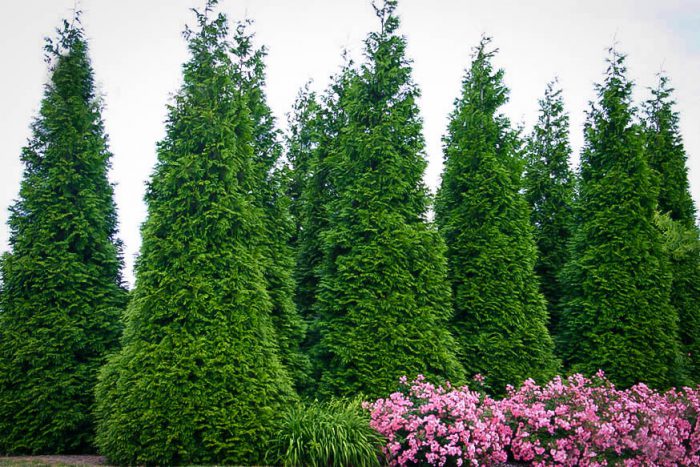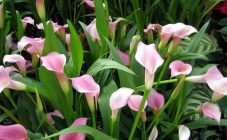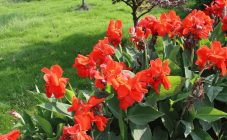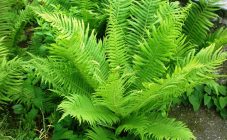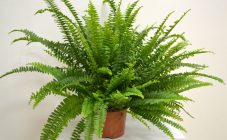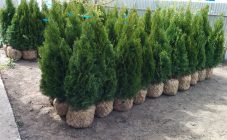Content:
Tuya is very popular with gardeners. It is perfect for creating hedges and paths. Landscape designers use it to create real masterpieces - original green figures. An evergreen tree is unpretentious and frost-resistant, so caring for a thuja in the country is not difficult.
Description of culture
Thuja belongs to the Cypress family. In its natural habitat, thuja grows up to 20 meters in height, but in Russia its height does not exceed 10 meters.
The most famous types of thuja:
- West... The most popular variety is Smaragd; Brabant, Teddy, Danica and many others are also well known;
- Oriental. Sorts "Aurea-variegata", "Elegantus", "Siboyadi" and others;
- Folded. The most famous varieties are Vinkord, Kankan, Gelderland.
Western thuja requires minimal care, so summer residents prefer this variety. An evergreen tree feels comfortable in the Moscow region. The culture is also suitable for cultivation in the Urals and Siberia.
In the form of thuja it happens:
- Conical or pyramidal;
- Dwarf;
- Spherical.
Planting a thuja in the country
Thuja can be planted in open ground until late autumn. An evergreen tree takes root best in April or May. It will hurt less and grow faster, because it is in the spring that the tree grows actively. In addition, the thuja will have a lot of time before frost to root properly.
Although the plant is unpretentious, it also has its own preferences. Therefore, before landing on the street, it is better to find out what the thuja loves.
It is recommended to grow thuja in partial shade. Quite in the shade, the tree develops slowly, the needles become sparse and dull. Culture also dislikes drafts. An ideal site for planting thuja is a windless place with little shade. There is no need to plant ephedra next to a large tree, it will suppress it, taking all the nutrients from the ground.
It should also take into account what kind of soil thuja loves. Although the culture grows in any soil, the optimal substrate for thuja is loam with weak acidity or neutral pH 4-5.5. It is not recommended to plant the plant in alkaline soil, as it is viscous and heavy, poorly permeable to moisture. For thuja to grow successfully, the soil must be sufficiently moistened. But water stagnation at the roots of the ephedra can destroy it.
Thuja seedling transplant
Breeding thuja at home with seeds or cuttings is a painstaking task, so most often homeowners buy seedlings from nurseries.
You should carefully examine the young tree before buying. The seedling should be lush and symmetrical. You can make sure whether the acquired thuja is alive as follows: you need to squeeze the seedling in your hand and release it. If the plant instantly takes its original shape, then everything is fine with it. Weed in the container is a good sign. This means that the ephedra overwintered in this pot, and it is strong enough, adapted to the winter cold.
After choosing a seedling, you can proceed to the process of replanting it:
- A planting hole should be prepared. The recommended pit diameter is 1 meter, its depth should be twice the size of the container;
- If the land is damp at the dacha, or the groundwater is very close, then drainage must be poured at the bottom of the planting hole at least 20 centimeters (gravel, crushed stone, broken brick or expanded clay). This will help avoid decay of ephedra roots;
- The next layer after drainage is to add sand or peat, leafy soil or sod mixture to the hole. This will provide the young tree with nutrients;
- Then you need to carefully immerse the seedling in the middle of the hole. So that the root collar is flush with the ground. The clod of earth on the roots of the seedling must be preserved. If the roots of the thuja are bare, then such a tree will not take root;
- Next, you need to fill the hole with a substrate obtained from equal proportions of peat, soil and sand;
- The planting hole must be carefully tamped and watered generously;
- It is recommended to mulch the soil immediately after transplanting the seedling. This will protect the soil from drying out and freezing in winter.
Thuja care
Care and cultivation in the garden of culture is not burdensome. The most important procedure is regular watering. In the summer, in the heat, it is good to water the ephedra by sprinkling. This will saturate its shoots with moisture and remove dust. It is better to water the tree in the morning or in the evening, when there is no longer such an active sun.
It is necessary to loosen the soil around the ephedra and remove weeds so that they do not take nutrients from the tree.
Do not forget about feeding. The first time the ephedra is fed 6 months after planting. Ammonium nitrate or urea, as well as Kemira Universal are suitable for feeding in spring or early summer. You can purchase special fertilizers for conifers.
Thuja diseases and pests
With improper care and lack of care for the tree, diseases arise. You should know that it is not recommended to feed the coniferous tree with organic fertilizers (chicken droppings or fresh manure). They contain many microorganisms that can cause this or that disease.
Thuja diseases:
- Brown shoots... This is an infection of a fungal nature, most often manifested with the arrival of spring. The scales of the bark begin to turn yellow, then the shoots are affected, and then die off. You need to fight the disease with the antifungal drug Fundazol. The tree is sprayed with a 2% solution in summer or autumn. Infected branches must be removed;
- Rust... It affects mainly young plants. Causes: Lack of nutrition, high humidity or hot weather. The plant is sprayed with the preparation "HOM" (for 10 liters of water 40 g), the affected areas of the thuja must be removed;
- Schütte... This is a fungal disease. A diseased tree has dark needles and falls off. Causes: poor care and lack of nutrition. To overcome the disease, you need to spray the tree with Topsin-M (solution - 15 g per 10 liters of water). Bordeaux liquid is also an effective remedy; it is sprayed with thuja;
- Phytophthora... The most dangerous fungal disease for thuja. Reasons: close proximity to groundwater and poor soil drainage. The fungus attacks the roots of the plant, and then the entire tree. The trunk becomes loose, and the bark and needles become gray. The tree will inevitably die, it is better to immediately remove and burn it. The soil must be disinfected.
Pests:
- Thuvaya aphid... The pest feeds on tree sap. The needles become yellow, and then crumble;
- Spider mite... Active in dry weather. The needles are affected with yellow spots, then crumble;
- Speckled moth... A parasite that gnaws through the tunnels of a plant. The needles turn brown and die off;
- False shield... The insect is light yellow in color. Thuja, which has been attacked by this pest, withers and dries over time;
- Wireworms... The parasites feed on the roots.As a result, the plant stops developing, and the needles dry up;
- Bark beetles... Pests gnaw through passages in the bark and lay eggs. The infected tree dies.
To combat pests, it is recommended to spray the trees with insecticides, repeat after 2 weeks. If for some reason it is not possible to purchase drugs, then you can use folk recipes against pests. For example, add liquid soap to water and spray the plant with the resulting solution. Add 40 g of soap to 1 liter of water. It helps against ticks, aphids and other parasites. You can dilute 2 tbsp. tablespoons of ammonia in a bucket of water and add washing powder (1 pinch) there, then spray the thuja. Aphids will die from ammonia fumes.
Even a novice gardener, knowing that he loves thuja, how to care for her in the garden, can grow a coniferous beauty full of health.
